Related Research Articles
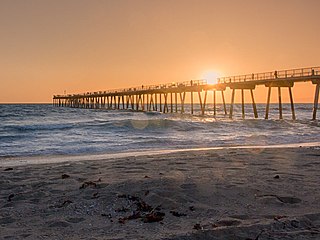
Southern California is a geographic and cultural region that generally comprises the southern portion of the U.S. state of California. It includes the Los Angeles metropolitan area as well as the Inland Empire. The region generally contains ten of California's 58 counties: Los Angeles, San Diego, Orange, Riverside, San Bernardino, Kern, Ventura, Santa Barbara, San Luis Obispo, and Imperial counties.

Los Angeles County, officially the County of Los Angeles, and sometimes abbreviated as L.A. County, is the most populous county in the United States, with 9,861,224 residents estimated in 2022. Its population is greater than that of 40 individual U.S. states. Comprising 88 incorporated cities and many unincorporated areas within a total area of 4,083 square miles (10,570 km2), it is home to more than a quarter of Californians and is one of the most ethnically diverse U.S. counties. The county's seat, Los Angeles, is the second most populous city in the United States, with 3,822,238 residents estimated in 2022. The county has been world-renowned as the domicile of the U.S. motion-picture industry since the latter's inception in the early 20th century.

San Bernardino County, officially the County of San Bernardino and sometimes abbreviated as S.B. County, is a county located in the southern portion of the U.S. state of California, and is located within the Inland Empire area. As of the 2020 U.S. Census, the population was 2,181,654, making it the fifth-most populous county in California and the 14th-most populous in the United States. The county seat is San Bernardino.

Howard Philip "Buck" McKeon is an American politician who served as a U.S. representative from California's 25th congressional district from 1993 to 2015. He is a member of the Republican Party. He is a former chairman of the House Armed Services Committee and the House Education Committee.

The Transverse Ranges are a group of mountain ranges of southern California, in the Pacific Coast Ranges physiographic region in North America. The Transverse Ranges begin at the southern end of the California Coast Ranges and lie within Santa Barbara, Ventura, Los Angeles, San Bernardino, Riverside and Kern counties. The Peninsular Ranges lie to the south. The name is due to the ranges' east–west orientation, making them transverse to the general northwest–southeast orientation of most of California's coastal mountains.
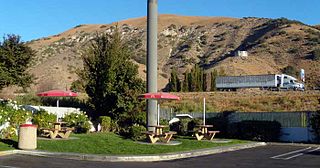
Gorman is an unincorporated community in northwestern Los Angeles County, California, United States. It is located in Peace Valley south of the Tejon Pass, which links Southern California with the San Joaquin Valley and Northern California. Due to this location, the area has served as a historic travel stop dating back to the indigenous peoples of California. Tens of thousands of motorists travel through Gorman daily on the Golden State Freeway since the highway's completion in the mid-20th Century.
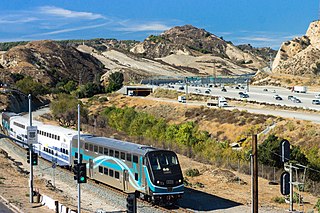
The Antelope Valley Line is a commuter rail line that serves the Northern Los Angeles County area as part of the Metrolink system. The northern segment of the line is rural in character because it travels through the sparsely populated Soledad Canyon between Santa Clarita and Palmdale, serving the small community of Acton along the way. Other portions of its route parallel the former US Route 6, now San Fernando Road and Sierra Highway. This is the only Metrolink line contained entirely within Los Angeles County.

Area code 661 is a telephone area code in the North American Numbering Plan for the southern part of the San Joaquin Valley and for the far northern part of the Los Angeles metropolitan area. The numbering plan area comprises most of Kern County, most of northern Los Angeles County, and small parts of Ventura County, Santa Barbara County, and Tulare County. It was created in an area code split of area code 805 on February 13, 1999.

The Pacific coast theater of the American Civil War consists of major military operations in the United States on the Pacific Ocean and in the states and Territories west of the Continental Divide. The theater was encompassed by the Department of the Pacific that included the states of California, Oregon, and Nevada, the territories of Washington, Utah, and later Idaho.
California's 23rd congressional district is a congressional district in the U.S. state of California. The district is represented in the 118th United States Congress by Jay Obernolte.
California's State Assembly districts are numbered 1st through 80th, generally in north-to-south order.
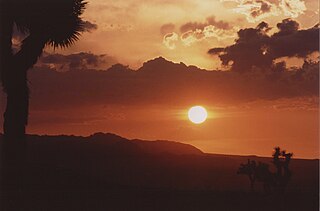
High Desert is a vernacular region with non-discrete boundaries covering areas of the western Mojave Desert in Southern California. The region encompasses various terrain with elevations generally between 2,000 and 4,000 ft above sea level, and is located just north of the San Gabriel, San Bernardino, and Little San Bernardino Mountains.
Phillip David Wyman was an American politician from California. A Republican, he was a member of the California State Assembly from 1978 to 1992 and again from 2000 to 2002; he was also a member of the California Senate from 1993 to 1994.
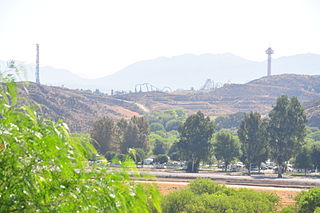
Valencia is an unincorporated community in northwestern Los Angeles County, California, United States. The area, west of Interstate 5, is expanding with residential development and already includes major commercial and industrial parks. It straddles State Route 126 and the Santa Clara River.

Jurupa Valley is a city in the northwest corner of Riverside County, California, United States. It was the location of one of the earliest non-native settlements in the county, Rancho Jurupa. The Rancho was initially an outpost of the Mission San Gabriel Arcángel, then a Mexican land grant in 1838. The name is derived from a Native American village that existed in the area prior to the arrival of Europeans.

California, the most populous state in the United States and third largest in area after Alaska and Texas, has been the subject of more than 220 proposals to divide it into multiple states since its admission to the Union in 1850, including at least 27 significant proposals prior to the 21st century.

Cal 3 was a proposal to split the U.S. state of California into three states. It was launched in August 2017 by Silicon Valley venture capitalist Tim Draper, who led the effort to have it originally qualify on the November 2018 state ballot as Proposition 9, officially the Division of California into Three States initiative. Proponents of the proposal argued that dividing California into three states would provide fairer and more responsive governance for large regions outside of California’s major cities. In July 2018, the Supreme Court of California pulled it from the ballot for further state constitutional review. Draper officially stopped pushing for the measure soon after. On 12 September 2018, the court permanently removed the measure from all future ballots.

The 2020 California State Senate election was held on Tuesday, November 3, 2020, with the primary election scheduled for March 3, 2020. Voters in the 20 odd-numbered districts of the California State Senate elected their representatives. The elections coincided with the elections for other offices, including for U.S. President and the state assembly.
References
- 1 2 3 4 Charles F. Bostwick. "Plan Mapped Out for New County; High Desert Area Would Contain 1 Million People". Daily News. Archived from the original on 2019-04-11. Retrieved 2016-02-26.
- 1 2 "If a new county is feasible, go for it, desert dwellers say". The San Bernardino County Sun. February 20, 1998. p. 4.
- 1 2 3 Jeff Wilson (April 26, 2013). "Save us Carl Boyer! SCV getting screwed by LA County again".
- ↑ Harris, Scott (1 March 1998). "Putting Secession on the Map". Los Angeles Times. Retrieved 25 February 2016.
- ↑ Maeshiro, Karen (15 April 1998). "Knight Bill Would Create Panel To Study Plan For New County". Daily News. Archived from the original on 4 May 2016. Retrieved 25 February 2016.
- ↑ "Knight Bill Would Create Panel to Study Plan for New County". Los Angeles Daily News. April 15, 1998. Archived from the original on May 4, 2016.
- ↑ "Secession". The San Bernardino County Sun. March 2, 1998. p. 4.